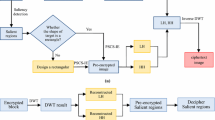Abstract
This paper studies the capability of non-salient image regions and pattern selection for advancing the security robustness of region-based watermark. However, considerable unpredictability in the assigning image region for encryption exists, since saliency map itself is changed specifically by particular encryption algorithm and saliency detection techniques. The change may lead to misguided selection of image region for decryption. A new solution for watermarking in non-salient region is described and evaluated to derive improvement of secrecy, integrity, and availability of images. This is achieved by using machine learning approach, which favors the advantageous selection of encryption region based on the variation between the salient maps before and after the encryption process. We validate the method by region selection evaluation and the correctness of decrypted messages. Experimental results show that a range of saliency models are adequate for the proposed watermark solution.
Access this chapter
Tax calculation will be finalised at checkout
Purchases are for personal use only
Similar content being viewed by others
References
Tirkel, A.Z., Rankin, G.A., Van Schyndel, R.M., Ho, W.J., Mee, N.R.A., Osborne, C.F.: Electronic Water Mark. In: DICTA 93, pp. 666–673. Macquarie University (1993)
Satapathy, S.C., et al.: Computer communication, networking and internet security. In: Proceedings of IC3T, p. 5 (2016)
Itti, L., Koch, C.: Computational modelling of visual attention. Nat. Rev. Neurosci. 2(3), 194–203 (2001)
Erdem, E., Erdem, A.: Visual saliency estimation by nonlinearly integrating features using region covariances. J. Vis. 13(4), 11, 1–20 (2013)
Hou, X., Harel, J., Koch, C.: Image signature: highlighting sparse salient regions. IEEE Trans. Pattern Anal. Mach. Intell. 34(1), 194–201 (2012)
Riche, N., Mancas, M., Gosselin, B., Dutoit, T.: RARE: a new bottom-up saliency model. In: Proceedings of the IEEE International Conference on Image Processing (2012)
Hou, X., Zhang, L.: Saliency detection: a spectral residual approach. In: IEEE Conference on Computer Vision and Pattern Recognition (2007)
Huang, C.-H., Ja-Ling, W.: Attacking visible watermarking schemes. IEEE Trans. Multimedia 6(1), 16–30 (2004)
Bhowmik, D., Oakes, M., Abhayaratne, C.: Visual attention-based image watermarking. In: International Symposium on Circuits and Systems (2011)
Niu, Y., Kyan, M., Ma, L., Beghdadi, A., Krishnan, S.: A visual saliency modulated just noticeable distortion profile for image watermarking. In: 19th ESP Conference (2011)
Niu, Y., Kyan, M., Ma, L., Beghdadi, A., Krishnan, S.: Visual saliency’s modulatory effect on just noticeable distortion profile and its application in image watermarking. Signal Process. Image Commun. 28(8) (2013)
Cox, I.J.: Digital Watermarking and Steganography. Morgan Kaufmann, Burlington, MA, USA (2008)
Mihcak, M.K., Kozintsev, I., Ramchandran, K., Moulin, P.: Low-complexity image denoising based on statistical modeling of wavelet coefficients. IEEE Signal Process. Lett. 6(12), 300–303 (1999)
Watson, A.B.: DCT Quantization Matrices Optimized for Individual Images. Human Vision, Visual Processing, and Digital Display IV, pp. 202–216. SPIE (1993)
Tian, L., Zheng, N., Xue, J., Li, C., Wang, X.: An integrated visual saliency-based watermarking approach for synchronous image authentication and copyright protection. Image Commun. 26, 427–437 (2011)
Sung, M., Li X., Lee, I.: Visual perception based robust watermarking with integral imaging, Optik – Inter. J. Light Electron Opt. 127(24), 11828–11839 (2016)
Basu, A., Talukdar, S., Sengupta, N., Kar, A., Chakraborty, S.L., Sarkar, S.K.: On the Implementation of a saliency based digital watermarking. In: Information Systems Design and Intelligent Applications, AISC 339, pp. 447–456. Springer India (2015)
Oakes, M., Bhowmik, D., Abhayaratne, C.: Global motion compensated visual attention based video watermarking 25(6), 061–624 (2016). SPIE
Gawish, A., Scharfenberger, C., Bi, H., Wong, A., Fieguth, P., Clausi, D.: Robust Non-saliency guided watermarking. In: 13th Conference on Computer and Robot Vision (2016)
Zhang, Z., Wu, L., Yan, Y.: An improved reversible image watermarking algorithm based on difference expansion. Int. J. Distrib. Sens. Netw. (2017)
Ji, S.-K., Kim, W.-H., Jang, H.-U., Mun, S.-M., Lee, H.-K.: Robust imperceptible video watermarking for MPEG compression and DA-AD conversion using visual masking. In: IWDW 2015: Digital-Forensics and Watermarking, pp. 285–298 (2015)
Tian, L., Zheng, N., Xue, J., Li, C.: Authentication and copyright protection watermarking scheme for H. 264 based on visual saliency and secret sharing. Multimed. Tools Appl. (2013)
Shih, F.Y., Zhong, X.: Intelligent watermarking for high-capacity low-distortion data embedding. Int. J. Patt. Recogn. Artif. Intell. 30, 1654003 (2016)
Barber, D.: Bayesian Reasoning and Machine Learning. Cambridge University Press (2012)
Milton, J.S., Arnold, J.C.: Introduction to Probability and Statistics, Principles and Applications for Engineering and the Computing Sciences. McGraw-Hill (1995)
Vapnik, V.N.: Invited speaker. In: IPMU Information Processing and Management (2014)
Borji, A., Cheng, M.-M., Jiang, H., Li, J.: Salient object detection: a benchmark. IEEE TIP 24(12), 5706–5722 (2015)
Powers, David M.W.: Evaluation: from precision, recall and F-measure to ROC, informedness, markedness and correlation (PDF). J. Machine Learn. Tech. 2(1), 37–63 (2011)
Winkler, W.E.: Overview of record linkage and current research directions (PDF). Research Report Series (2006)
Author information
Authors and Affiliations
Corresponding author
Editor information
Editors and Affiliations
Rights and permissions
Copyright information
© 2020 Springer Nature Singapore Pte Ltd.
About this paper
Cite this paper
Anh, D.N., Huy, P.Q., Mai, L.C. (2020). Watermark by Learning Non-saliency. In: Satapathy, S., Bhateja, V., Nguyen, B., Nguyen, N., Le, DN. (eds) Frontiers in Intelligent Computing: Theory and Applications. Advances in Intelligent Systems and Computing, vol 1013. Springer, Singapore. https://doi.org/10.1007/978-981-32-9186-7_7
Download citation
DOI: https://doi.org/10.1007/978-981-32-9186-7_7
Published:
Publisher Name: Springer, Singapore
Print ISBN: 978-981-32-9185-0
Online ISBN: 978-981-32-9186-7
eBook Packages: Intelligent Technologies and RoboticsIntelligent Technologies and Robotics (R0)




